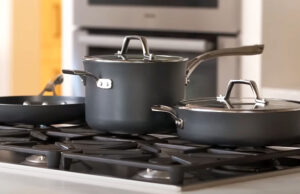As an Amazon Associate, I earn from qualifying purchases at no extra cost to you.
Neff Dishwasher Error Code E15: Easy Ways to Fix It Fast
If your Neff dishwasher shows error code E15, it usually means water has leaked inside. Don’t worry. You can often fix it quickly yourself. First, turn off the dishwasher and unplug it for safety. Next, check the base for water. Wiping the water and resetting the machine often stops the error. Many people panic when they see E15, but with a few simple steps, you can get your dishwasher working again without calling a repair person. Let’s go through the full guide.
Check and Empty the Dishwasher Base
The E15 error usually happens because water collects in the base of the dishwasher. This water triggers the safety sensor. First, unplug the dishwasher and remove the lower front panel carefully. Place a towel underneath to catch any water. Then, check the base for standing water. If you see water, gently soak it up with a sponge or cloth.
Sometimes the water comes from a small leak. Check hoses and connections near the bottom. Even a little drip can trigger E15. If you find a leak, fix it by tightening connections or replacing worn hoses. Next, make sure nothing inside the dishwasher blocks the drainage. A clogged filter or spray arm can cause water to sit in the base.
After cleaning the base, allow it to dry for at least 30 minutes. You can leave the panel off and air dry. Then, plug the dishwasher back in and try running a short cycle. If the E15 error disappears, the problem was just water in the base. If not, the leak may still be active, and you need to check hoses or seals more carefully.
- Turn off and unplug the dishwasher
- Remove front panel and check base for water
- Soak up any standing water
- Inspect hoses and connections
- Ensure filters and spray arms are not clogged
- Let base dry before testing machine
Inspect and Clean the Filter
A blocked or dirty filter can cause water to build up, which triggers E15. Start by removing the lower rack. Take out the filter carefully. Rinse it under warm running water. Use a soft brush to remove stubborn debris. Avoid sharp tools that can damage the filter. Cleaning the filter improves drainage and reduces the chance of leaks.
Next, check the area where the filter sits. Sometimes food bits or small objects get stuck under the filter. These can block water flow and trigger the error. Clear any debris with a cloth or small brush. Also, look at the drain at the bottom. Remove any obstructions. Make sure everything fits snugly when you put the filter back.
After cleaning, reassemble the filter. Push it firmly into place but do not force it. Run a short rinse cycle without dishes. Watch the base for any leaks. If water is still present or E15 appears again, the problem may be deeper, like a damaged pump or hose. Cleaning the filter is a simple first check that solves many common issues.
- Remove and rinse the filter
- Use soft brush to remove debris
- Check under filter and drain for food bits
- Reassemble carefully
- Run short cycle to test
Check for Leaks in Hoses and Seals
Leaks in hoses or seals are a common reason for E15 errors. Start by inspecting the water inlet hose at the back. Make sure it is tight and not cracked. Then, check the drain hose for any kinks or loose connections. Even small cracks can let water escape. Replacing a damaged hose is easy and inexpensive.
Next, check seals around the door. Open the door and examine the rubber gasket. Look for cracks, holes, or worn areas. If the gasket is damaged, water can escape during a cycle. Clean it with a damp cloth to remove dirt. If damaged, replace the gasket. Sometimes water leaks from connections under the dishwasher. Remove the base panel and inspect these areas carefully.
After fixing leaks or replacing hoses and seals, dry everything. Reassemble the dishwasher. Run a short cycle with no dishes. Watch closely for any water escaping. If the E15 error stops, you found the source. If not, the leak might be hidden or the float switch might need attention. Checking hoses and seals is one of the most effective ways to prevent future errors.
- Inspect water inlet and drain hoses
- Tighten loose connections
- Check door gasket for cracks
- Clean or replace damaged seals
- Look under base panel for leaks
- Test cycle after fixing

Reset the Dishwasher
Sometimes E15 stays on even after fixing leaks. A reset can clear the error. Start by unplugging the dishwasher for at least five minutes. This allows the electronic control to reset. Some Neff models have a reset button. Press it while the machine is off. If your model does not, turning it off and on works the same.
After unplugging, check that the base is dry. Water in the base will immediately trigger E15 again. Use a towel to dry any moisture. Plug in the dishwasher and start a short cycle without dishes. Watch closely. If the error disappears, the dishwasher is ready to use. If E15 still appears, check the float switch or sensor next. A reset is a simple way to clear minor electronic issues.
If your dishwasher frequently shows E15 even after resetting, there may be a persistent leak or sensor problem. Keep an eye on hoses and door seals. Sometimes small leaks are hard to spot. Regular cleaning and maintenance help prevent E15 from returning. Resetting is a quick fix, but it only works if the root cause is gone.
- Unplug dishwasher for 5 minutes
- Press reset button if available
- Ensure base is dry
- Start short cycle to test
- Check hoses and seals if error returns
Examine the Float Switch
The float switch detects water in the base and triggers E15. If it is stuck or dirty, it can falsely detect a leak. First, unplug the dishwasher. Remove the bottom panel. Locate the float switch, usually a small plastic piece that moves up and down. Check that it moves freely. Clean any debris around it.
If the float switch seems stuck, gently free it. Sometimes soap residue or dirt blocks movement. Test the switch by pressing it up and down. It should move smoothly and click when pressed. Reassemble the dishwasher and run a short cycle. If E15 stops, the float switch was the problem. If not, it may need replacement.
Float switches are reliable, but they are sensitive. Even small crumbs or hard water deposits can cause false readings. Regular cleaning prevents errors. If your dishwasher is older, consider replacing the float switch if it frequently triggers E15. It is a small part but very effective for fixing this common error.
- Locate and inspect float switch
- Check for free movement
- Clean any dirt or residue
- Test by pressing up and down
- Replace if malfunctioning
Call a Professional if Needed
If you have tried all the fixes and E15 still appears, it may be time to call a professional. Some leaks are hidden or parts are damaged internally. A qualified technician can safely check pumps, sensors, and electrical components. This saves time and prevents further damage.
Before calling, gather information. Note when E15 appears and what you have tried. Take pictures if possible. This helps the technician diagnose faster. Keep your dishwasher manual handy. Professionals often refer to it for specific part locations and codes. Remember, calling a repair service is not a failure. Some issues need expert handling.
While waiting for help, do not run the dishwasher. Water leaks can damage your floor. Use towels to soak any water in the base. Be patient. Most technicians can fix the issue quickly once they identify the source. Following a professional’s advice ensures your dishwasher works safely for years to come.
- Gather information and take notes
- Call certified technician
- Avoid running dishwasher
- Use towels to soak water
- Keep manual handy for reference
Final Thoughts
Neff dishwasher E15 is common but manageable. Most of the time, small leaks or dirty parts cause it. Cleaning, checking hoses, and resetting often fixes the problem. If not, a professional can help. With care and attention, your dishwasher can run smoothly again.
| Issue | Solution |
|---|---|
| Water in base | Remove panel, soak up water |
| Dirty filter | Remove, clean, reassemble |
| Leaks in hoses | Inspect, tighten, replace |
| Door gasket | Clean or replace |
| E15 persists | Reset dishwasher |
| Float switch | Clean, test, replace |
| Persistent issues | Call professional |
Frequently Asked Questions (FAQs)
Is it safe to run the dishwasher with E15?
No, running the dishwasher with E15 can cause water damage. The error means water has leaked into the base. Operating it could worsen the leak and damage the floor. Always unplug the dishwasher first. Soak any water in the base and inspect for leaks. Only restart after resolving the issue or having a technician check it.
Can I fix the E15 error myself?
Yes, many E15 errors are simple to fix. Cleaning the filter, drying the base, checking hoses, or resetting the machine often solves the problem. However, if leaks are hidden or parts are damaged, professional help is safer. Take your time and follow the steps carefully. Safety matters when dealing with water and electricity.
Do I need special tools to fix E15?
No special tools are usually needed. A towel, sponge, and basic screwdrivers are enough for most fixes. You may need pliers for hose clamps. For parts replacement like float switches or gaskets, follow instructions carefully. Simple household tools cover most DIY repairs safely and effectively.
Is it normal for E15 to appear suddenly?
Yes, E15 can appear suddenly. Small leaks or debris can trigger it without warning. Sometimes a dish or utensil blocks the filter, causing water to stay in the base. Regular cleaning helps prevent sudden errors. Watching your dishwasher closely for the first few cycles can prevent repeated E15 occurrences.
Can a clogged filter cause E15?
Absolutely. A clogged filter blocks water flow. Water can pool in the base, triggering E15. Cleaning the filter regularly prevents this. Remove food bits, rinse under warm water, and use a soft brush. This simple step solves many errors and improves dishwasher performance.
Do I need to replace the float switch often?
Not usually. Float switches are durable. However, if it gets stuck or fails to move freely, it may need replacement. Regular cleaning prevents buildup and false errors. Older machines with frequent E15 errors may benefit from a new float switch.
Can E15 be caused by a damaged door seal?
Yes, a damaged gasket can leak water during a cycle. Inspect the rubber seal for cracks or holes. Cleaning or replacing the gasket often stops leaks and the E15 error. Door seals are easy to maintain and crucial for dishwasher safety.
Is professional repair expensive for E15?
It depends. If it is a simple leak or part replacement, costs are moderate. Hidden leaks or pump issues may cost more. Calling a certified technician ensures a proper fix and avoids repeated errors. Often, paying for expert help is cheaper than long-term DIY mistakes.




